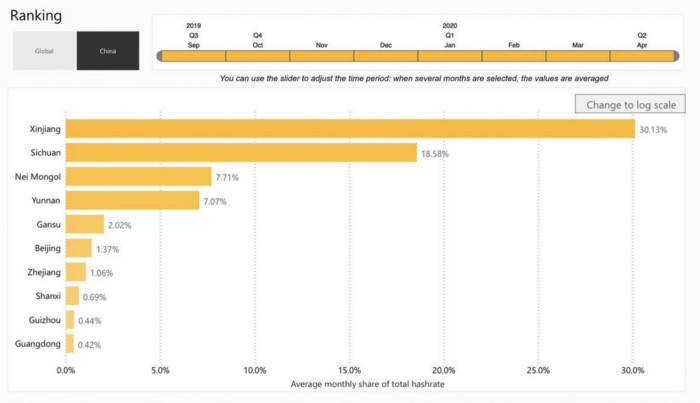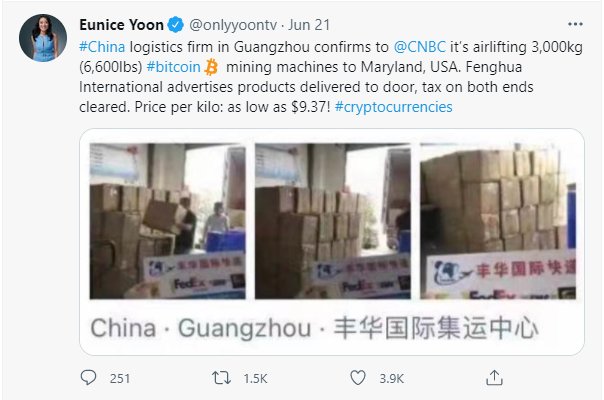Introduction
I wanted to publish some of my thoughts on the recent Bitcoin mining ban in China along with some data sources which I believe provide helpful context and draw powerful conclusions.
What happened?
China’s State Council, or cabinet, vowed to crack down on mining in late May, seeking to fend off financial risks after the global bitcoin mania revived Chinese speculative trading in cryptocurrencies. The clampdown comes as China’s central bank is testing its own digital currency.
What does this mean for Bitcoin Mining?
The current Bitcoin mining ban in China is not much of a surprise as the country has “flip-flopped” on a variety of Bitcoin issues for years. The first ban was back in 2013, where the PBOC prohibited banks from dealing with Bitcoin. In 2017, the government also banned initial coin offerings that had thrived at the time, hugely due to the success of Bitcoin and other altcoins such as Ethereum. Bitcoin mining is one of the few Bitcoin sectors that has avoided the China “ban-hammer” possibly due to cheap electricity from overbuilt coal and hydro power plants.
Centralization of Bitcoin mining hashrate in China has been recognized for many years. According to the University of Cambridge, they estimate China provides 65% of Bitcoin’s hashrate, with three main provinces making up the bulk of that computing power (keep in mind, these are only estimates and no one can know with certainty where all hashrate is located because a significant portion of global bitcoin hashrate is anonymous). These three regions are Xinjiang, Inner Mongolia and Sichuan. Sichuan instituted a ban against bitcoin mining asking electricity companies to disconnect power to any bitcoin mining operations they encountered.

Results of the mining ban
The results of the current ban depend on how you look at it. In one instance, it may seem like bad news because an outright ban from one of the largest countries in the world is not something to be happy about.
For the average person and mainstream adoption of Bitcoin in China, these decisions don’t help Bitcoin hashrate across the globe in the short-term. In the long-term this may actually increase distribution in hashrate across the globe. According to the chart below, China has the highest monthly hashrate, followed by the U.S. at a very distant second.

Price
What is interesting is the fact that the price has been reasonably resilient through this news. Price traded between the weekly high of $36,460 and a low of 32,775, as volatility declines whilst price consolidates. This is huge news and there wasn’t too much volatility in the price as a result. The current price stability shows the maturity and liquidity of the bitcoin market.

Mining Distribution
Additionally, the Bitcoin mining network turns out to be more distributed and resilient than many had expected. This recent ban might indicate that bitcoin mining may not be as centralized in China as originally thought.
Transactions/Mempool
Although data indicates that more than 50% of miners are based in China, the network has not experienced any major slowness in transaction processing even though the protocol experienced the largest difficulty adjustment in history, adjusting down 27.94%. Most transactions can clear the next block for less than 30 sats per byte. The mempool is pretty empty right now. This may also mean that a lot of bitcoin transactions may have moved to centralized 3rd parties such as Square Cash App or Coinbase.

Now is a good time to be in the mining game. With this major difficulty adjustment and shuffle in the mining network, less competitive miners can become more profitable. Old and inefficient Antminers S9’s are probably being turned on right now.
Glassnode Insights shows us that the “the daily aggregate revenue now around $25M to $30M per day, but is shared amongst a smaller pool of miners. Same daily BTC issuance, fewer competitors to share the spoils. This implies that following the latest difficulty adjustment, operational miners are incurring the same OPEX expense, but are seeing profitability rise almost 2x, approaching similar profitability levels to back in April.”
If you have a miner, plug it in and start hashing to take advantage as this is a good arbitrage play right now.

What happens next?
This recent ban will make the bitcoin mining network stronger and more resilient than it already is. It will push miners to become more creative and self-sovereign. Chinese miners are going to do one or more of the following:
Go out of business or shut down their mines until the wind blows in a different direction. It will take some time for miners to either move their machines to favorable jurisdictions or liquidate their assets before setting up in other regions.

Move to another favorable jurisdiction outside of China to continue operations such as the U.S., Middle East or Canada. According to CNBC, Hong Kong-headquartered mining pool, Pooling, is in the process of diversifying its mining hashrate by moving to the United States and Canada.
Move towards off-grid mining solutions where they have more control over their power supply. This is hugely due to the constant challenges associated with the Chinese government towards Bitcoin. This is a big boost for Solar, Natural Gas, or Wind powered Bitcoin Mining. An excellent recent article by Marty Bent from Great American Mining predicts a rise in off-grid mining because of the risks associated with on-grid bitcoin mining.
Chinese miners will resort to much more creative ways and unique business models to mine.
Mining is about to boom in the United States, Canada and the Middle East. There are boatloads and planeloads of ASIC miners coming over to these countries right now from China. The ripple effect will be felt in the next 1–3 months as Chinese miners get set-up to resume operations.
CNBC reported that Texas might be the next mining region in the U.S. hugely because it has some of the world’s lowest energy prices and its share of renewables is growing over time. Governor Greg Abbot tweeted an article from Bitcoin Magazine titled “How Texas Is Becoming A Mecca For Bitcoin Miners” that talks about how former governor of Texas, Rick Perry, called miners “a major accelerant for job creation and sustainable economic growth in the state,” while current governor Greg Abbott has put out the welcome mat for bitcoin mining companies.

Other political leaders such as City of Miami Mayor Francis Suarez are trying to entice the Chinese miners to Miami. “We want to make sure that our city has an opportunity to compete,” Mayor Francis said in a recent CNBC article. “We’re talking to a lot of companies and just telling them, ‘Hey, we want you to be here,” he said.
Across the state of Florida, nuclear energy is the second-biggest power generator, after natural gas. Suarez is already in talks with Florida Power & Light Company to figure out how to further drive down the price of energy.
“We understand how important this is…miners want to get to a certain kilowatt price per hour. And so we’re working with them on that,” Suarez told CNBC.
Conclusion
Time will tell how the geopolitical ramifications of this decision will turn out. China will probably be less of a player in the mining industry after the “Great Migration”. This is good for Bitcoin but probably bad news for China. This may put China at a big disadvantage long-term.
There are good and bad takes from the Bitcoin mining ban in China. Overall it’s an inevitable part of Bitcoin’s journey. Major bitcoin bans like this make people more aware of Bitcoin. It will force Bitcoin to become more anti-fragile over time and increase decentralization and innovation in bitcoin mining.
